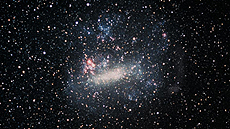Start spreading the SNEWS
 |
A worldwide network keeps astronomers and physicists ready for the next nearby supernova. Photo courtesy of NASA
|
When it comes to studying supernovae, if you don't SNEWS, you lose.
SNEWS, the Supernova Early Warning System, is a worldwide network designed to do just what the name implies: let astronomers and physicists know when a nearby supernova appears. This can be a tricky business, since supernovae appear in our galaxy roughly once every 30 years, and the window for studying them can vary — anywhere from a few weeks down to a few hours.
Seeing a supernova in action is certainly a great chance to learn about how supernovae work. But it's the burst of neutrinos released in a supernova that most interests Kate Scholberg and Alec Habig, the two physicists who spearheaded SNEWS. Scholberg and Habig were postdoctoral researchers on the Super-Kamiokande neutrino experiment when the idea was first discussed in the late 1990s.
"There is enormous potential to learn about neutrinos from supernovae," says Scholberg, now a professor at Duke University. "We can learn about their properties, like their mass, their ability to oscillate and potentially exotic effects. Furthermore, with supernova neutrinos, we get the complete story of the stellar core collapse, a story that is of great interest to a lot of theorists."
The trick is to catch them. Neutrinos are the most abundant particles in the universe, and physicists know very little about them. That's because they're notoriously elusive — they rarely interact with matter and have miniscule masses. Terrestrial neutrino experiments fire billions of the tiny particles at massive detectors every few seconds and see only a few interactions a week.
Supernova neutrinos are even more difficult to pin down. As Habig, now a professor at the University of Minnesota, Duluth, explains, neutrinos are often the first sign of a supernova, arriving before anyone knows what's happening.
"You get the neutrinos before you get the light," Habig says. "It takes hours before you see the photons. Depending on the type of star, it could take up to 12 hours for the photons to blast their way out of the dying star, but the neutrinos escape immediately."
It's that very principle that allows SNEWS to work. It starts with five of the biggest neutrino experiments in the world: Super-Kamiokande and KamLAND in Japan, the Large Volume Detector and Borexino in Italy, and IceCube in Antarctica. Each experiment can detect supernova neutrinos.
Once potential supernova neutrinos are detected in one of these experiments, a datagram is sent to the SNEWS computer, housed at Brookhaven National Laboratory in New York. If multiple datagrams indicate that two bursts of neutrinos arrived within ten seconds of each other, the computer automatically alerts the SNEWS mailing list. According to Habig, there are nearly 2,700 email addresses on the list, although some of those addresses send to lists themselves. (Sky & Telescope magazine's AstroAlert list receives SNEWS alerts, for example.)
Read more
—Andre Salles
|